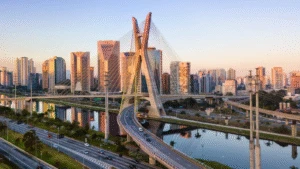Labor Day weekend marks the unofficial end of summer—and for travelers, it can also mean some of the year’s highest prices and biggest crowds. But savvy travelers don’t have to get squeezed by inflated airfares, hotel rates, and airport congestion. With a strategic approach to Labor Day travel, you can keep expenses in check, minimize environmental footprint, and still meet obligations in comfort—wherever work or time away takes you.
This guide explores the unique cost challenges of holiday travel, reveals smart booking tactics, and shares tools that help dodge surge pricing and hidden fees. Along the way, discover local, sustainability-focused strategies that work in major business hubs from coast to coast, where mindful choices make it easier to work, eat, and move with a lighter impact.
The Perfect Storm: When Holiday Demand Meets Business Necessity
The TSA expects to screen over 17 million people this weekend, setting a record that reflects how crowded Labor Day travel has become. Most travelers fly out the Friday before Labor Day and return Monday, the holiday itself. This peak demand allows airlines and hotels to significantly raise prices, especially for last-minute bookings.
NerdWallet data shows the Friday before Labor Day is historically the most expensive day to fly. In 2024, there were 9% more travelers that Friday compared to the previous week, according to TSA. Meanwhile, Monday, September 1, becomes the busiest and often most expensive day for returning home. For business travelers, this means higher fares and longer lines.
Labor Day’s role as the last major summer getaway creates a perfect storm: crowded airports, sold-out hotels, and surge-priced rideshares—even as many businesses expect employees back at their desks on Tuesday. For small business owners and self-employed professionals, these costs can quickly erode margins and productivity.
Smart Timing and Strategic Booking for Holiday Business Travel
Flexibility with your schedule is your biggest asset during holiday travel. When possible, leaving a day earlier or extending your return by a day can lead to much lower fares and less crowded airports. Flying on Tuesday or Wednesday before Labor Day, or returning Wednesday after the holiday, usually avoids the weekend crush. Even departing early Saturday morning and returning Sunday night can help dodge peak pricing.
Early booking remains the gold standard for both flights and accommodations. Rates tend to climb as the holiday approaches, and inventory dwindles. Booking at least a month in advance helps lock in reasonable rates and secure preferred properties—especially in destination cities like San Francisco, Chicago, or Miami. Look for accommodations with free cancellation policies, allowing rebooking if better deals emerge later.
Hotel loyalty programs and direct booking often unlock member-only rates and perks—many chains guarantee their lowest prices to loyal customers. For business travelers focused on sustainability, platforms like Dyme specialize in curating eco-conscious stays that align with values while often offering exclusive rates unavailable elsewhere. This is a core component of any effective sustainable business travel strategy.
Outsmarting Dynamic Pricing and Holiday Surges
Airlines and hotels use sophisticated algorithms to adjust prices in real time based on demand. This means fares can double (or more) during peak periods like Labor Day weekend. Combat this by tracking prices over time using tools like Google Flights, Kayak, or Going , which send alerts when fares drop. Early booking generally provides the safest bet, but flexible plans sometimes yield last-minute deals as properties and airlines try to fill empty seats and rooms.
Alternative airports often deliver surprising savings across major business destinations. In the Bay Area, compare San Francisco (SFO) with Oakland (OAK) and San Jose (SJC). For Chicago trips, check both O’Hare (ORD) and Midway (MDW). Los Angeles travelers should explore LAX, Burbank (BUR), and Long Beach (LGB) options. Connecting flights, while less convenient, frequently cost significantly less than nonstop options.
Instead of defaulting to chain hotels downtown, explore extended-stay properties, boutique hotels, or eco-certified options prioritizing energy efficiency, waste reduction, and local sourcing. These alternatives exist across all major business centers—from Portland’s eco-conscious hotels to Austin’s sustainable lodging scene.
Finding Hidden Value Through Alternative Routes and Destinations
Popular destinations like Miami, Las Vegas, and Seattle see the biggest Labor Day crowds—and the highest prices. When business allows flexibility, consider routing through (or basing in) second-tier cities or emerging business districts. For meetings in Silicon Valley, staying in San Jose instead of San Francisco can deliver significant savings. Chicago’s River North might be pricier than staying in nearby neighborhoods with excellent transit connections.
Regional transportation often provides cost-effective alternatives during peak periods. Amtrak’s Northeast Corridor serves Boston to Washington, D.C., while the Pacific Surfliner connects Los Angeles to San Diego. The Capitol Corridor links San Francisco Bay Area cities. These trains offer reliable Wi-Fi and workspace, making them practical for business travelers while helping to reduce carbon emissions from business travel.
Secondary business districts and suburban locations frequently feature lower hotel rates and more availability during peak periods. Dallas’s Plano area, Seattle’s Bellevue, or Atlanta’s Buckhead often provide easier access to corporate headquarters while offering better value than downtown cores.
Essential Technology and Platforms for Cost-Conscious Travel
Smart travelers rely on multiple platforms to track deals and compare options. Google Flights, Kayak, and Skyscanner allow fare comparison across airlines, price alerts, and flexible date exploration. Going (formerly Scott’s Cheap Flights) specializes in mistake fares and deeply discounted tickets, sending real-time alerts to inboxes. For hotels, aggregators can help, but booking directly—or through curated platforms like Dyme—often yields the best combination of price, perks, and sustainability.
Even infrequent travelers benefit from signing up for hotel and airline loyalty programs, which are free and can lead to instant savings, room upgrades, or bonus points for future stays. Credit cards with travel rewards help offset costs, especially when paying for flights or hotels with cards offering cash back or points for travel purchases.
Sometimes bundling flights and hotels (or adding car rentals) through a single platform unlocks package discounts. However, for business travelers prioritizing sustainability, booking accommodations separately through platforms specializing in low-impact options often proves more beneficial.
Sustainable Business Travel Strategies Across Major Markets
Each major business destination offers opportunities for sustainable travel choices. In Seattle, look for hotels with LEED certification and restaurants emphasizing Pacific Northwest ingredients. Portland’s eco-conscious culture makes finding sustainable accommodations and zero-waste dining particularly easy. San Francisco’s commitment to environmental leadership translates into numerous green-certified hotels and farm-to-table restaurants.
Chicago’s bike-share system and extensive public transit make car-free business travel feasible, and the city also offers many sustainable hotels for conferences. Its focus on locally sourced cuisine supports sustainable dining choices. Austin’s commitment to “keeping it weird” includes a thriving sustainable food scene and eco-friendly accommodations that align with business travelers’ environmental values.
In warmer destinations like Miami or Phoenix, seek hotels with energy-efficient cooling systems and water conservation programs. These cities often feature robust bike-sharing programs and walkable business districts that reduce transportation emissions.
Public transit systems in major business hubs—from Washington D.C.’s Metro to San Francisco’s BART—offer sustainable alternatives to rideshares and rental cars. Many cities also provide electric vehicle charging at hotels and business centers, making EV rentals increasingly practical.
Making Labor Day Work Travel Both Smart and Sustainable
Labor Day travel for work doesn’t require overspending or unnecessary stress. Early booking, off-peak travel, and choosing eco-conscious accommodations and transit help reduce costs while lowering your environmental footprint.
That impact starts with smart planning, flexible scheduling, and aligning with providers that prioritize sustainability and support local communities. Whether you’re heading to the Pacific Northwest, the South, or anywhere in between, a more thoughtful trip is within reach.
Already thinking ahead? Take a moment to review this business travel checklist — a practical guide to help you prepare with low-impact choices in mind.
Explore Dyme across major business destinations for low-impact travel.






